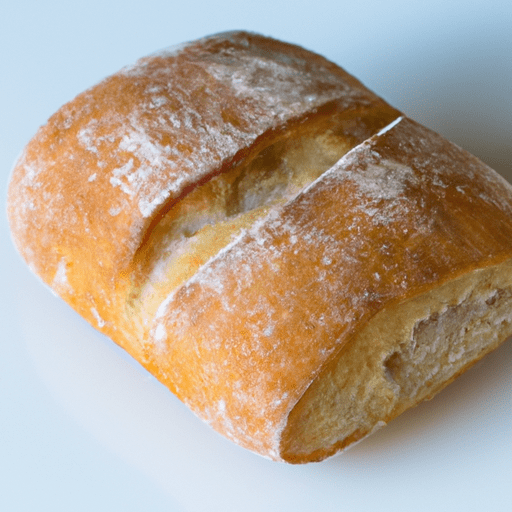The Allure of Ciabatta Rolls: A Crusty Delight
Ciabatta rolls have certainly made a name for themselves in the culinary world, and with good reason. These Italian-born bread rolls are beloved for their distinctive flavor, versatility, and unique texture. In this article, we’ll dive into the delights of ciabatta rolls, including their taste, common uses in cooking, nutritional value, and some intriguing history and facts.
Taste and Texture:
Ciabatta rolls are known for their delectable taste, distinguished by a subtle hint of wheat and a slightly tangy sourdough flavor. As soon as you bite into a freshly baked ciabatta, you’ll be met with a light and airy interior that is riddled with large airholes. The crust, on the other hand, is delightfully chewy and golden-brown, characteristic of the bread’s long fermentation process. This combination of textures creates a truly satisfying eating experience.
Common Uses in Cooking:
Ciabatta rolls’ versatility makes them a dream for cooks and food lovers. They can play multiple roles in a meal, enhancing various dishes with their unique qualities. Here are just a few of the many ways you can enjoy ciabatta rolls:
Sandwiches: Ciabatta rolls are perfect for sandwiches and paninis. The crusty exterior holds up well against juicy fillings, while the airy interior provides a soft and absorbent base.
Bruschetta: Toasted and topped with fresh tomatoes, garlic, olive oil, and herbs, ciabatta rolls make for heavenly bruschetta. The bread’s sturdiness allows it to carry the flavorful toppings without getting soggy.
Dipping: Serve warm slices of ciabatta with flavorsome dipping oils or soups. The bread’s airy structure soaks up the deliciousness, making every bite a delight.
Crostini: Sliced thin and toasted in the oven, ciabatta transforms into an elegant base for various appetizers. Top it with anything from creamy spreads to cured meats and cheeses.
Nutritional Value:
When it comes to nutritional value, ciabatta rolls offer a decent balance. They are a source of carbohydrates, providing energy for your body. However, it’s worth noting that ciabatta rolls are not particularly high in fiber or protein compared to whole wheat or grain-based breads. It’s always a good idea to consider portion sizes and pair ciabatta rolls with other nutrient-dense foods to create a well-rounded meal.
History and Facts:
Ciabatta rolls originated in the 1980s in Italy. The name “ciabatta” actually means “slipper” in Italian, reflecting the bread’s shape and resemblance to a house slipper. Unlike traditional Italian bread, ciabatta was specifically designed to be an alternative to the classic baguette. It was created to meet the demands of consumers seeking a bread with a softer interior and a rustic crust.
Interestingly, ciabatta’s development came about due to advances in technology. Modern dough mixers and ovens allowed bakers to experiment with a higher hydration dough, resulting in the characteristic airiness and crustiness of the ciabatta rolls we know today.
Conclusion:
Ciabatta rolls offer a delightful culinary experience, combining a unique taste with a versatile nature. Whether you enjoy them as a base for sandwiches, a complement to soups, or a foundation for appetizers, these crusty rolls bring a certain flair to the table. So, if you’re looking to elevate your meals with a touch of Italian charm, consider picking up a batch of fresh ciabatta rolls and savoring the flavors of this delectable treat.
Ciabatta Rolls
Origin: Ciabatta rolls, also known as ciabatta bread, originated in Italy. They were first created in the 1980s in the Veneto region, specifically in the city of Verona. The term “ciabatta” literally translates to “slipper” in Italian, which refers to the shape of the bread resembling a slipper.
Common Uses: Ciabatta rolls are often used to make sandwiches or as a side to soups, stews, and salads. Due to their slightly chewy texture and porous nature, they are perfect for absorbing excess liquids, making them ideal for dipping or soaking in sauces. They can also be used as a base for bruschetta or turned into garlic bread.
Nutritional Benefits: Ciabatta rolls are typically made with simple ingredients, including flour, water, yeast, and salt. They provide a good source of carbohydrates, which are essential for energy. However, it’s worth noting that they can be high in calories and may not be suitable for those looking for a low-calorie option.
Unique Properties: Ciabatta rolls are characterized by their distinct shape, which is flat and elongated, with a thin, crispy crust and a soft, airy interior. The dough is usually wet and sticky, resulting in a light and holey crumb. Due to its high hydration level, ciabatta dough requires a longer fermentation process, allowing the gluten to develop and giving it its characteristic texture.
Historical Significance: The creation of ciabatta rolls is attributed to a baker named Arnaldo Cavallari, who wanted to make a bread reminiscent of the rustic breads of the past. He aimed to create a bread that would have a crispy crust yet remain soft and chewy on the inside. His invention quickly became popular in Italy and has since gained popularity worldwide. Today, ciabatta bread is a staple in many bakeries and supermarkets globally.




Use the share button below if you liked it.
It makes me smile, when I see it.